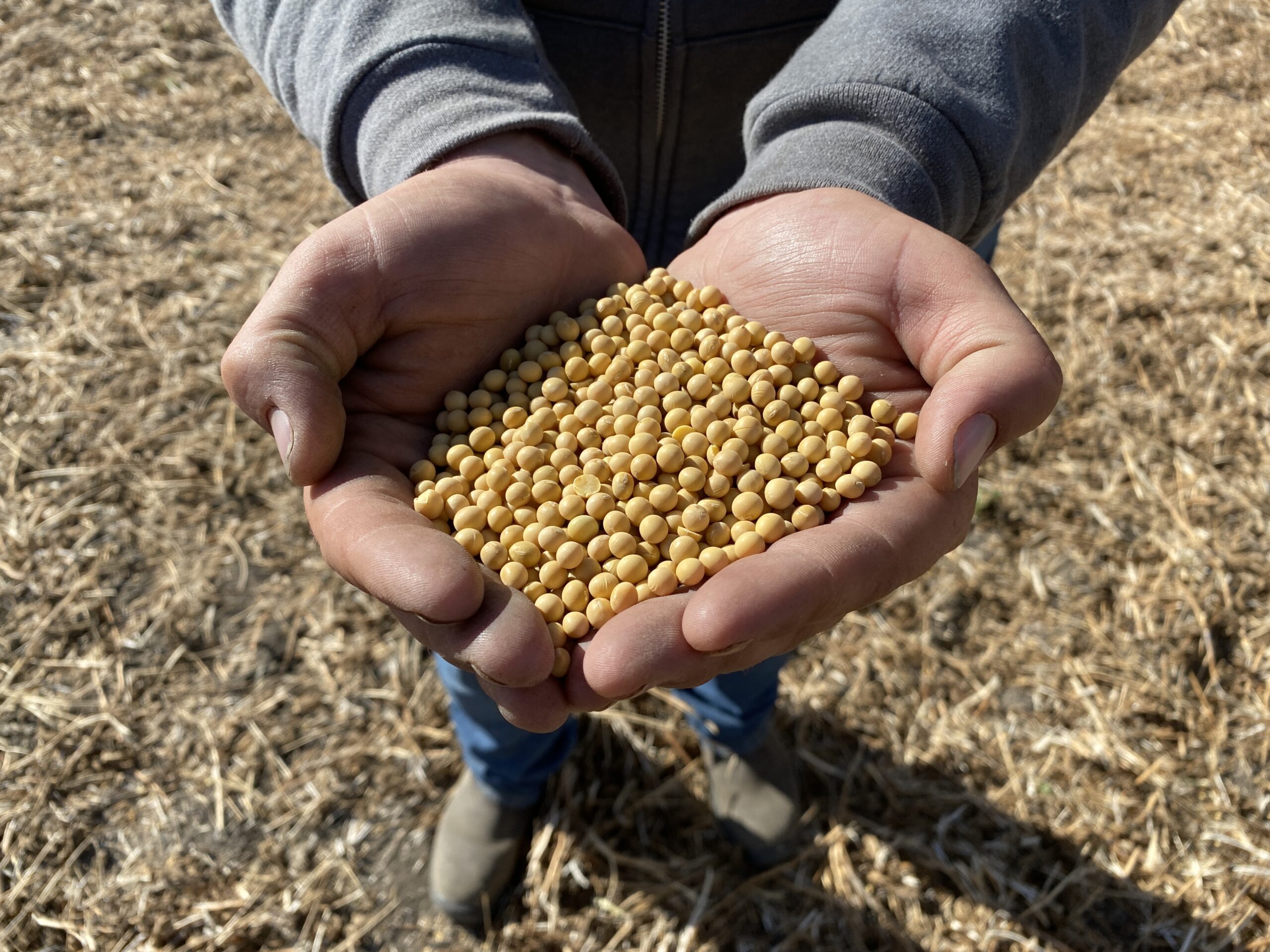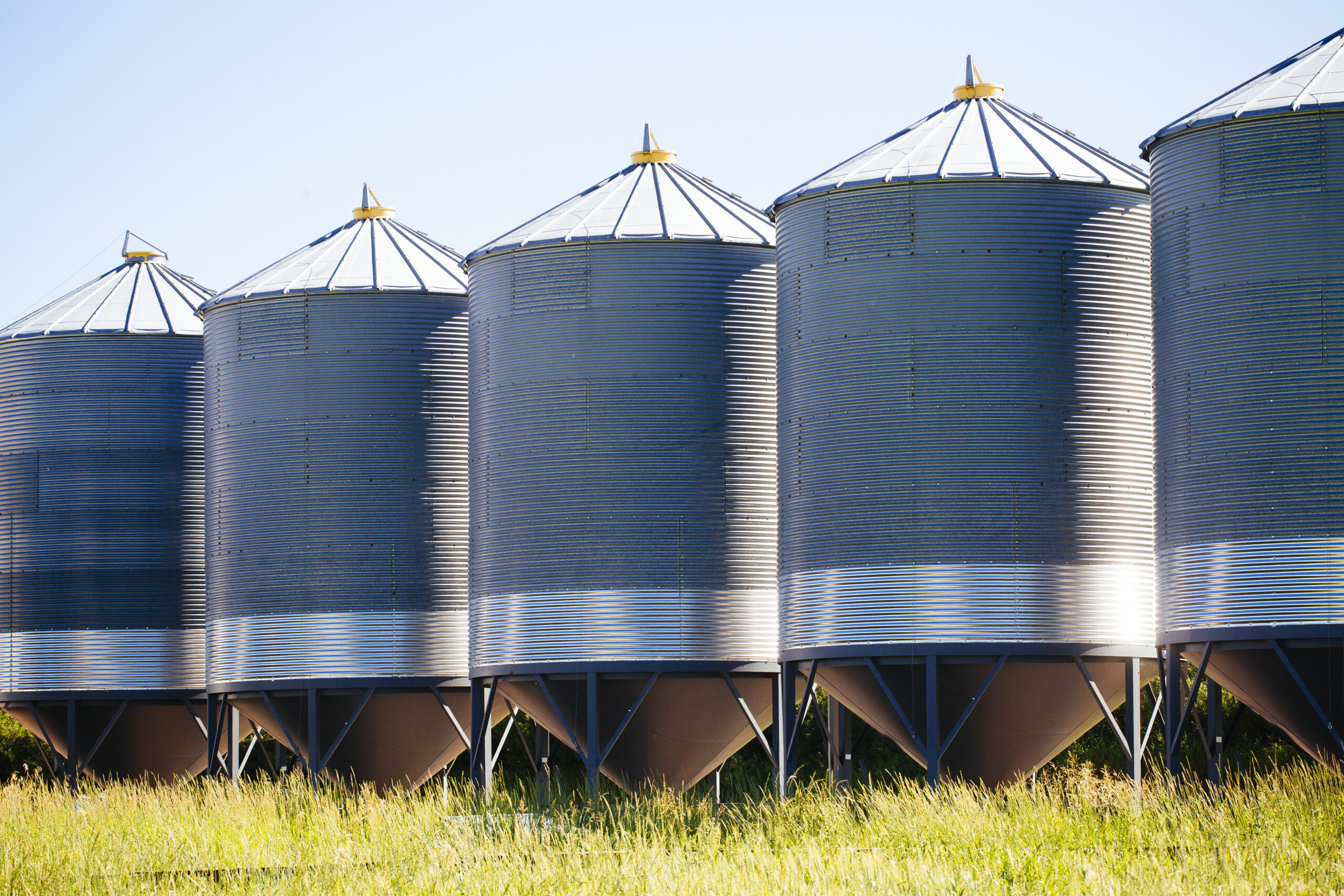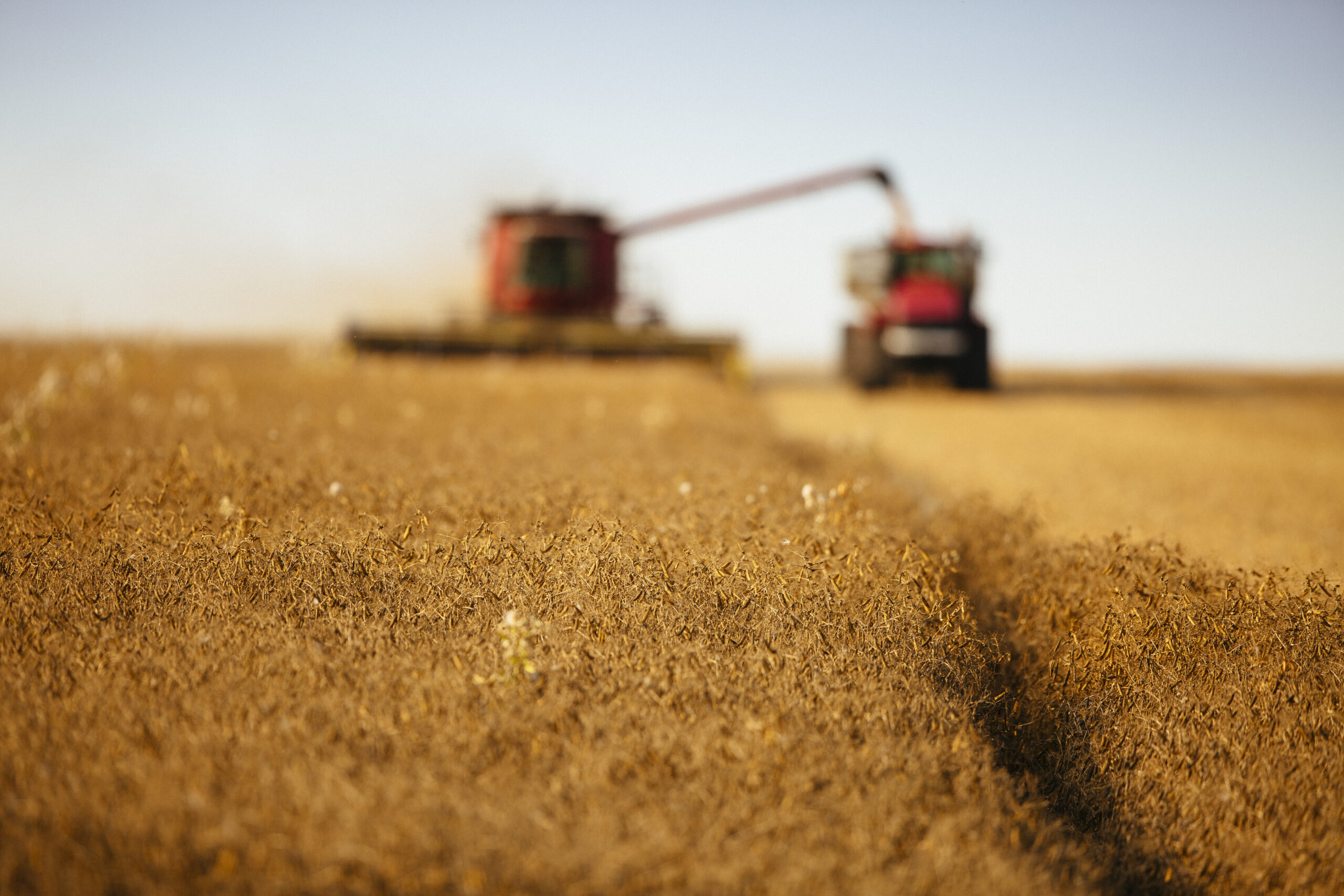Harvest Tips for Soybeans
Adapted from Bruce Barker, P.Ag.
When to Harvest

Source: Manitoba Pulse and Soybean Growers, Soybean Maturity Guide
Soybeans begin to mature as defoliation begins. Leaves begin to dry down and fall off the main stem, while the pods turn from yellow to brown. Soybeans reach full maturity (R8) when 95% of the pods are brown (Figure 1). Seeds inside the pods will rattle and all the leaves will have dropped. At maturity, it is important to consider seed moisture to determine harvest time.
Assessing your soybean crop for risks of setting green seed and frost damage can determine when you harvest your soybean crop. If green seed is present in a soybean crop and the beans are left to stand in hopes of the green seed coat changing colour, growers run the risk of combining very dry seed. Seed damage due to mechanical handling is high when soybeans are harvested at less than 12% seed moisture, and can incur greater harvest losses under very dry conditions as well.
Whether to harvest soybeans with soft/green seedcoats depends on the overall percentage of green seed. If less than 2% of seed has green seedcoats, then harvesting could proceed as normal as the seedcoats will turn colour in storage.
However, if more than 3% of the sample has green seedcoats and rainfall is in the forecast, a good strategy would be to wait for rainfall to re-wet the seed and allow natural ripening to uniformly clear the green colour. This is a strategy often used by seed growers. An additional caution is that if the crop is harvested with a high percentage of green seed, smearing of the green seed may occur.
Harvest Moisture
While the ideal seed moisture for harvest and storage is 13%, soybean harvest can begin at seed moistures up to 20% as they do dry down well under aeration. Delaying harvest until seed moisture is less than 13% can result in increased shatter loss, increase seed coat damage, or splits as well as yield (weight) loss (Table 1). If stems or leaves remain green and tough, do not delay harvest until green stems mature if seed moisture is ideal. Time harvest to avoid a hot afternoon when soybeans will be at their driest and are most sensitive to mechanical damage.
Table 1. Potential Loss From Delivering Soybeans at Less Than 13% Moisture
| Seed Moisture Level | Potential Yield Reduction |
|---|---|
| 8% | 5.4% |
| 9% | 4.4% |
| 10% | 3.3% |
| 11% | 2.25% |
| 12% | 1.14% |
Source: University of Nebraska-Lincoln Crop Watch “Plan Harvest to Deliver Soybeans at the Optimum Moisture”
Straight Cut Soybeans
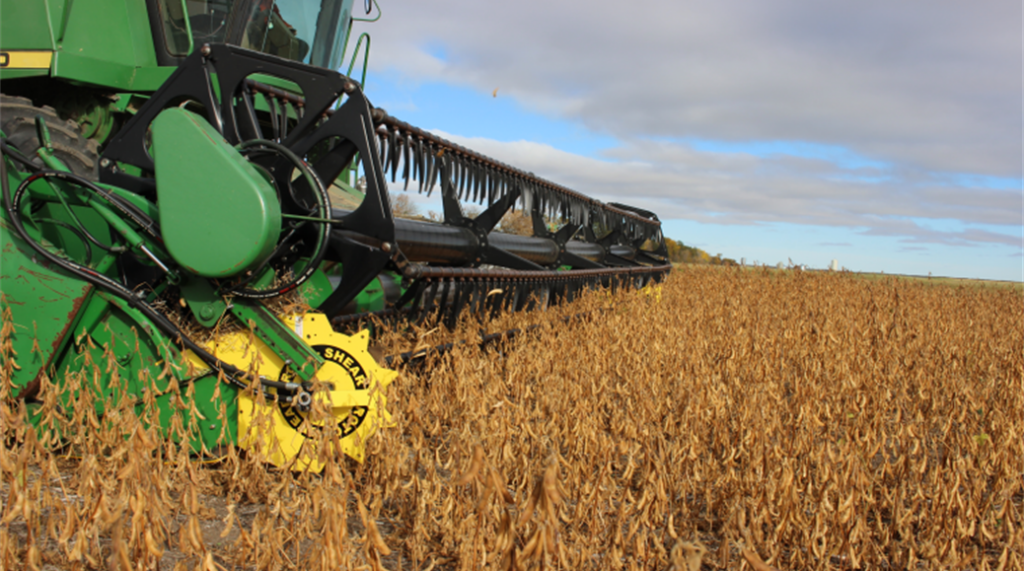
Soybeans should be straight cut at harvest. Swathing soybeans is not recommended due to increase risk of shattering losses. As well, soybeans have very little plant material to create a swath and little stubble to act as a anchor. Therefore, swaths would be susceptible to movement by wind and pick-up could be difficult (Figure 2).
Soybeans Do Not Require Desiccation
Soybeans do not require desiccation as they are able to dry down nicely as they mature. Yield and quality are maximized if soybeans are left to mature naturally in the field. If green, weedy material is a concern in the field, there are a number of registered pre-harvest products that can be used on soybeans.
Setting the Combine and Harvest Speed
- Combines should be set properly.
- Concave clearance and cylinder speed should be set to avoid seed cracking.
- Reel speed should be no more than 25-50% more than ground speed, to avoid cutter bar shatter.
- The majority of soybean seed loss at harvest occurs at the cutter bar.
- Cutting as close to the ground as possible will help capture low pods.
- Consider the use of a flex header to help reduce losses.
- Checking for seed loss is important as four seeds per square foot on the ground equals one bushel per acre of yield. Loss should ideally be no more than 5% of the total yield.
Studies have shown that yield loss increases with increased harvest speed. Speeds of over four miles per hour (6.4 kilometres per hour) has been shown to increase the risk of harvest loss.
Handling Soybeans
Soybeans should be handled gently at harvest. The seed coat of soybeans is susceptible to mechanical damage and the drier the soybeans, the more prone they are to splits. Using conveyors and avoiding over handling can also help avoid cracking and damaging the seeds, which can result in increased dockage. Grading factors for soybeans includes: foreign material, test weight, damage (heated, mouldy, splits), downy mildew, and mixed colours.
Drying and Storage
If harvest occurs when soybean moisture is above 13%, soybeans should be conditioned to bring moisture down. Soybeans can be dried using any drying method. If using a grain dryer, care should be take to avoid over-drying the soybeans to prevent shrinkage. Dried grain needs to be cooled down using fans or aeration after drying. If drying soybeans using natural air in aeration system, it is best done with a full aeration floor to ensure even movement of air and drying. Bins should be temperature monitored to ensure no heating occurs.
For proper staging and harvest management, Manitoba Pulse and Soybean Growers has developed a soybean staging guide.
Seed Quality
Soybean production in Saskatchewan has its challenges, with one of the main issues being frost and the potential for frost-damaged seed. It is not uncommon for certain parts of the province to experience soft and/or green soybean seed due to frost on immature soybeans. Soft, green seed can also be caused by the rapid maturity of a moisture-stressed crop following a dry summer and fall.
These challenges are not unique to Saskatchewan producers, Dennis Lange, Provincial Pulse Specialist with the Government of Manitoba, has seen similar issues early in Manitoba soybean harvests in previous years where downgrading issues were not the result of early frost but rather a dry production season followed by rapid crop maturity.
Impact of Frost on Soybeans
Temperatures of 0°C for an extended period of time will cause damage to top growth in soybeans and temperatures of –2.2°C or colder can kill soybean plants entirely.
Other factors can also impact the degree of frost:
- Canopy thickness (narrow, thick rows will maintain heat longer)
- Soil moisture (moisture in the soil will maintain heat)
- Cloud cover (cloudy is better)
- Wind speed (windy is better)
It is a good idea to assess your field prior to a potential frost to understand the staging and maturity of your soybeans beforehand, and to understand the potential impact a frost may have.
What Will Happen to Soybeans if There is a Frost?
A light frost (0 to -1°C) may kill top leaf growth but will not penetrate the canopy. Soybean plants should continue to mature but will take longer and there may be some green seed in pods where leaves were killed. Frost killed leaves will remain attached to the plant.
A hard frost (<-1°C) will cause damage to green stems, pods, and seeds, reducing yield and quality and may kill the entire plant. When entire plants are killed, seed fill stops because photosynthate can no longer be translocated. Beans that were green and immature (R-5 to R-6) will shrivel and remain green. This is worst case scenario. Beans that were green-yellow (R-6.5) will have a mixture of green seed that will not mature and yellow seed that will mature. Mature, yellow beans (R-7) will continue to dry down slowly with minimal yield and quality loss.
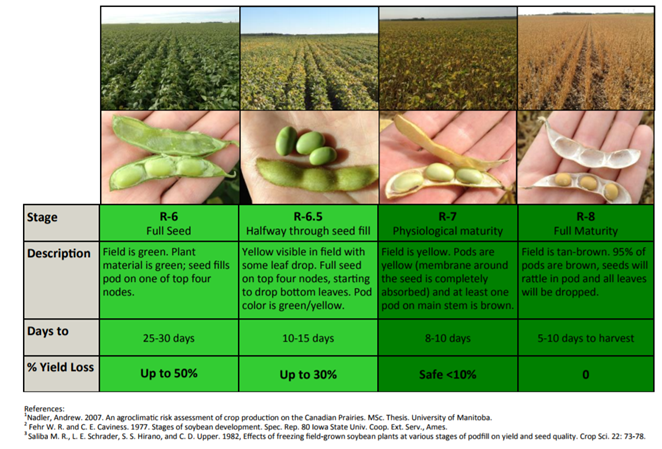
Green Seed Coat Versus Frost
To determine whether green seed is caused by frost, the Canadian Grain Commission’s (CGC) protocol is to cut the seed in half. Frost-damaged soybeans, when cut in cross-section, have cotyledons that are green or greenish-brown with a glassy, wax-like appearance.
The CGC grading information indicates that seeds whose cotyledon are yellow, or have just a halo of green around the outside of the cotyledon, are considered sound, even if they are superficially affected by weathering. Soybeans that are green in appearance and have no discolouration of the cotyledon, or just a halo of green around the outside of the cotyledon, are to be assessed against the overall colour of the sample, and are not to be graded lower than Soybeans, No.2 Canada Yellow.
Seeds whose cotyledon are yellow or have just a halo of green around the outside of the cotyledon are considered sound.
Managing Green Seed Coat
In Manitoba, rainfall helped to clear the green seedcoat on soybeans in the field. Rain re-wets the seed and the entire crop then dries down more uniformly, resulting in normal seedcoat colour.
Storage also helps. When put in storage, the green seedcoat matures, and the color turns to that of a mature soybean. After several weeks to a month of storage, most of the seeds with green seedcoats will have turned colour.

Canadian Grain Commission Soybean Grading Factors
Soybeans can be downgraded if the sample has damaged seed. Damaged soybeans include those which are sprouted, frost-damaged, shriveled, ground-damaged, insect damaged, immature, or otherwise unsound. For example, No. 1 Canada soybean tolerates 2% damaged seed.
Seeds where the inside cotyledon is green, fall into the category of Immature. Immature, damaged soybeans are characterized by a green exterior appearance in conjunction with green discolouration penetrating the cotyledon. Examination of the cotyledons is determined by cutting the soybeans in cross-section. For grading purposes, immature, damaged soybeans are considered as part of the “Total Damage” grade specification.
Soybean Protein Content
Soybean protein content on the Prairies is lower than in other parts of the world. Compared to the mid-west of the United States and southern Ontario, protein content drops as production moves north and west. Increased scrutiny on protein content in Saskatchewan and Manitoba soybeans has resulted in soybean buyers to downgrade low protein soybeans by up to 32% in previous years.
Canadian Grain Commission (CGC) data shows that western Canadian soybeans are generally lower in protein than eastern Canadian soybeans but the gap has been narrowing (Figure 4). Ten years ago, western Canadian soybeans were generally 3-4% lower in protein content than eastern Canadian soybeans. This spread has narrowed to around 2%. However, CGC data shows that there is a range of protein content. In Western Canada, the mean protein level in No. 1 and No. 2 soybeans was 38.5%, with a range of 36-40%.

Source: Canadian Grain Commission
Research has not yet identified the reason for lower soybean protein content on the Prairies. As shown in Figure 4, protein content varies year-to-year, suggesting environmental conditions have a large impact on protein content. Another possible reason is that breeding for high yield and earlier maturity has sacrificed protein content.
Protein content can vary by variety so there is some genetic component to protein content as well. Most research with varieties has demonstrated a strong variety by environment correlation for protein content. The details in terms of environmental factors and genes involved have yet to be determined and there are a number of research projects currently underway to shed more light into what controls the protein levels.
Current research indicates that growers can employ few managment practices to maximize their seed protein potential:
- Ensure the soybean crop has sufficient nitrogen, up to 50 lb/ac, as well as adequately inoculated, can improve amino acid composition and seed protein content.
- Soybean crops produced on fields with diverse crop rotations have been shown to produce higher protein content seed compared to soybeans grown in tighter crop rotation systems according to research conducted at Kansas State University.
- General best management practices such as no-till, targeting ideal soil temperatures and early planting when possible, lower target plant populations, using seed treatments, correct herbicide application timing and fungicides when needed were all shown to aid in seed protein content.
- Seed selection. Maturity group ratings were not found to significantly influence seed protein content in northern US, but longer maturing varieties tended to set higher protein in the southern US. Therefore choosing the correct soybean variety for your growing region (aka growing degree days) is more important for harvest management and other downgrading factors such as green seed and the risk of frost damage.
Protein content of soybean varieties from Saskatchewan Regional Variety Trials is available on Saskatchewan Pulse Growers’ (SPG) website.
